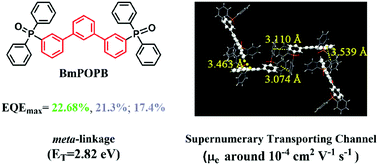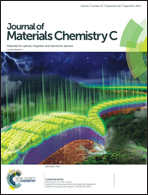Optimized electron-transport material based on m-terphenyl-diphenylphosphine oxide with the harmonious compatibility of high ET and electron mobility for highly efficient OLEDs†
Abstract
Two electron transporting materials, [1,1′:3′,1′′-terphenyl]-3,3′′-diylbis(diphenylphosphine oxide) (BmPOPB) and [1,1′:3′,1′′-terphenyl]-4,4′′-diylbis(diphenylphosphine oxide) (BpPOPB), have been designed and synthesized by appending a diphenylphosphine oxide moiety to the m-terphenyl core via meta- and para-linkage topologies. The influence of different linking modes on the thermal, photophysical, electrochemical, and electron transport properties of the compounds is systematically studied. Through the meta-linkage topology and supernumerary transporting channel assisted by diphenylphosphine oxide, the harmonious compatibility of a high triplet energy level (ET) of 2.82 eV and a high electron mobility of around 10−4 cm2 V−1 s−1 for BmPOPB has been achieved. When BmPOPB was used as an electron-transport material (ETM), the Ir(ppy)3-based green device hosted by CBP exhibited excellent performance with a maximum external quantum efficiency (EQE) of 22.68%; FIrpic-based and 2CzPN-based blue OLEDs hosted by mCP displayed maximum external quantum efficiencies (EQEs) of 21.3% and 17.4%, respectively. All the device performances outperformed that of its isomer BpPOPB and the typical ETM, 1,3,5-tris(1-phenyl-1H-benzo[d]imidazol-2-yl)benzene (TPBi). This contribution rationally demonstrated the significance of the harmonious compatibility in designing electron-transport materials for high-performance OLEDs.



 Please wait while we load your content...
Please wait while we load your content...